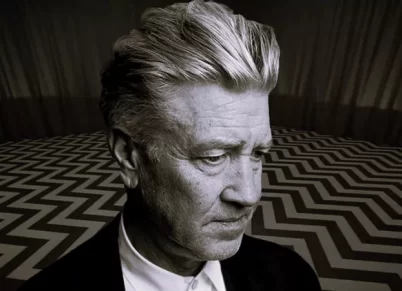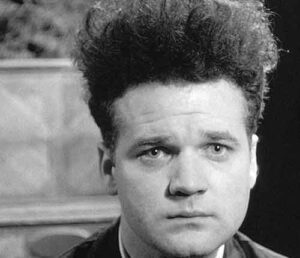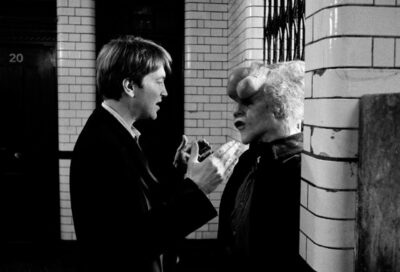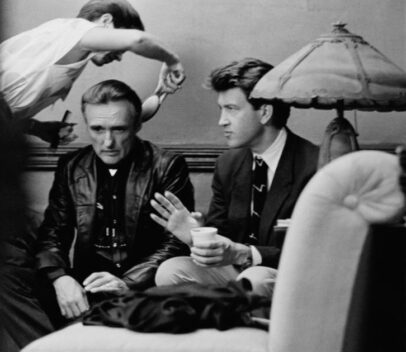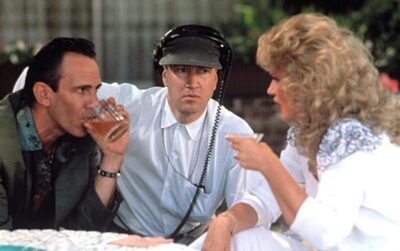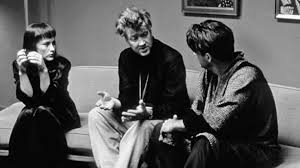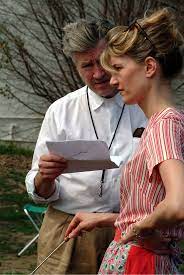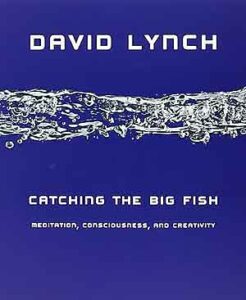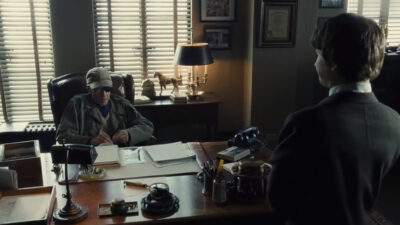The incomparable David Lynch had a creative breadth that encompassed graphic art, music and even writing (with his book CATCHING THE BIG FISH serving for many as a modern-day equivalent to ZEN AND THE ART OF MOTORCYCLE MAINTAINANCE or JONATHAN LIVINGSTON SEAGULL). It was filmmaking, however, in which Lynch’s visionary genius found its full expression. Here I’ll take a look back at his fifty-plus year career in film, decade by decade.
The 1970s
The inception of David Lynch. He began his artistic journey as a painter, only to switch to filmmaking in the late 1960s, when it seemed he was on his way to becoming an experimentalist along the lines of James Broughton or Larry Jordan.
Jordan, an avant-garde animator who on occasion turned his attention to live action, seems most in line with Lynch’s sensibilities. Lynch, in fact, got his start with a handful of animation-heavy shorts that included SIX MEN GETTING SICK (1967) and THE ALPHABET (1969).
SIX MEN GETTING SICK (1967)
THE ALPHABET (1969)
He broadened his scope in 1970 with THE GRANDMOTHER, about a young boy getting revenge on his abusive parents by growing a loving grandmother out of a mound of dirt. By early Lynch standards the film was a veritable epic, running an exorbitant 34 minutes and intermingling live action with hand-drawn animation.
THE GRANDMOTHER was financed in part by the American Film Institute, where Lynch, according to classmate Ed Zwick, was already being recognized as the genius he was. It was at AFI that Lynch put into production the feature length ERASERHEAD (1977), which took five years to make and, due in no small part to the efforts of midnight movie impresario Ben Barenholtz, became a midnight movie hit. That’s despite the fact that the film was fully in keeping with the underground sensibilities of Lynch’s earlier work, being gross, oppressive and plain weird—yet also undeniably artful and poetic.
The 1980s
ERASERHEAD’s success, in a development that should surprise nobody, propelled Lynch to in-demand status. Underground filmmakers generally don’t do well in the American studio, or even independent, film system, as evidenced by the careers of underground auteurs turned unlikely Hollywood darlings like Beth B. and Alejandro Jodorowsky—whose EL TOPO (1970) jumpstarted the midnight movie phenomenon, and who crashed and burned with an expensive 1970s adaptation of Frank Herbert’s DUNE. Lynch had his own misadventure with DUNE, but first he was employed by Mel Brooks, who according to Lynch told him, “You’re a mad man. I love you.”
The Brooks produced film in question, the period biopic THE ELEPHANT MAN (1980), came about after Lynch’s attempts at filming his famous RONNIE ROCKET script (which, sadly, remained unmade at the time of Lynch’s demise). Unable to interest financiers, he chose to abandon the project and film somebody else’s script, showing that Lynch, one of the most fiercely independent filmmakers of all time, was still finding his way.
This isn’t to say he didn’t make the most of his director-for-hire status on THE ELEPHANT MAN, turning out an impressively crafted product that nabbed him an Oscar nomination, or that his sensibilities and predilections weren’t yet formed. Lynch reportedly turned down an offer to direct FAST TIMES AT RIDGEMONT HIGH (1982), according to screenwriter Cameron Crowe, because it was “not my material.” He also shunned George Lucas, who tried to interest Lynch in helming RETURN OF THE JEDI (1983).
THE ELEPHANT MAN (1980) Trailer
Instead he signed onto DUNE (1984), a mega-production produced by the legendary Dino de Laurentis. Unlike Jodorowsky, Lynch at least managed to get his DUNE finished, but the film was a disaster in every particular. Its only real attributes were the fact that it acquainted Lynch with several members of his future acting stable (including Everett McGill, Alicia Witt and Kyle MacLachlan) and introduced the transitional effects (excess dissolves, whispered voice-overs, etc.) Lynch tended to employ when he wasn’t in full control of his material (things that would turn up in great abundance in TWIN PEAKS: FIRE WALK WITH ME).
It was with BLUE VELVET (1986), the de Laurentis bankrolled follow-up to DUNE, that Lynch finally hit his filmmaking stride. It was a defiantly personal, fiercely idiosyncratic film whose every particular was tightly controlled by Lynch. He worked once again with ERASERHEAD cinematographer Fredrick Elmes and DUNE headliner Kyle MacLachlan, and was introduced to another major collaborator: composer Angelo Badalamenti, whose instrumental score and dreamy Julee Cruise voiced song “Mysteries of Love” were instrumental in imparting what we now know as “Lynchian.”
The result of their combined efforts was one of the decade’s key films, a major critical success that netted Lynch his second Best Director Oscar nomination. To his credit, he took that success and ran with it, for better and, as we’ll see, worse.
The 1990s
The decade in which Lynch reached the nadir of his success, and also his greatest popular backlash. Lynch’s first notable post-BLUE VELVET venture was, unexpectedly, a small screen affair: the ABC TV series TWIN PEAKS, which premiered in April 1990. Television back then was considered a ghetto format unworthy of serious artistes; the weird and wonderful TWIN PEAKS, created in collaboration with TV veteran Mark Frost, didn’t exactly change that perception (THE SOPRANOS and BREAKING BAD were still several years in the future), but it did expand the possibilities of the medium considerably.
TWIN PEAKS TV Series (Trailer)
Further Lynch/Frost small screen endeavors followed, including the docu-series AMERICAN CHRONICLES (1990), the sitcom ON THE AIR (1992) and the miniseries HOTEL ROOM (1993). None, alas, attained a shade of their iconic predecessor’s viewership (although I say the latter two were not without interest).
HOTEL ROOM (1993) Episode 3, “Blackout”
TWIN PEAKS, for all its success, can be said to have sowed the seeds of its own destruction. Its driving query, “Who Killed Laura Palmer?,” wasn’t strong enough to sustain a 2 season, 30 episode series, not least because Lynch and Frost admittedly weren’t too interested in answering it (they were forced into doing so by ABC). Lynch’s attention was drawn more to the sounds and texture of the show’s bizarre small town universe, and also the performers, who included Sheryl Lee, Sherilyn Fenn, Lara Flynn Boyle, Ray Wise and (once again) Kyle MacLachlan, most of whom have never equaled their work on TWIN PEAKS.
1990 also marked the release of WILD AT HEART, Lynch’s more-is-better take on Barry Gifford’s minimalistic noir pastiche of the same name. Strongly foreshadowing the films of Quentin Tarantino in its envelope-pushing (for the time) violence and pop culture infected narrative, the film wasn’t too popular in its day. In fact, it upset many with its nastiness and admittedly varying quality (I like WILD AT HEART a fair amount, but can’t deny that it’s a bit uneven). That upset melded with the dissatisfaction toward the second season of TWIN PEAKS to form a most unpleasant backlash.
The target of that double-barred ire was TWIN PEAKS: FIRE WALK WITH ME (1992), Lynch’s big screen TWIN PEAKS spinoff. The film showcased Lynch at his best and worst in its depiction of the harrowing final days of Laura Palmer (Sheryl Lee), with some truly powerful, wrenching moments juxtaposed with a lot of filler (Ms. Palmer doesn’t even turn up until the halfway point). Trying to forge new cinematic ground while maintaining continuity with the series resulted in an unwieldy concoction, albeit one that didn’t deserve the overwrought condemnation it received.
By his own admission, Lynch “couldn’t get arrested” in the years following FIRE WALK WITH ME’s release. His long running L.A. READER comic strip “The Angriest Dog in The World” was cancelled, as were several film projects. He did at least publish an art book, IMAGES, in 1994 (which has since become an expensive collector’s item) and executive produce Michael Almereyda’s arthouse vampire pic NADJA the following year. It took until 1997 for Lynch’s next feature, LOST HIGHWAY, to appear.
The film broke new ground in the Lynch cannon, setting up an elaborate mystery that, rather than the gradual unsorting that occurred in BLUE VELVET and TWIN PEAKS, only grows increasingly labyrinthine and impenetrable as the film advances. LOST HIGHWAY didn’t quell the decade’s anti-Lynch fervor, but did show that he was in no mood to compromise his vision, even in the face of overwhelming public indifference.
THE STRAIGHT STORY (1999), a Disney production whose narrative construction is summed up by its title, tends to be viewed as a “departure” for Lynch. I beg to differ. The film, a fact-based depiction of an old man (Richard Farnsworth) on an epic lawnmower trek to visit his dying brother (Harry Dean Stanton), is chock-full of characteristic touches, notably the lovingly textured depiction of small town America, highly deliberate pacing and overall love of bizarrie, exemplified by the protagonist’s stammering daughter (Sissy Spacek), who speaks in a most Lynchian manner.
THE STRAIGHT STORY (Trailer)
The 2000s
In which Lynch regained his former glory, only to fall unexpectedly silent on the cinematic front. MULHOLLAND DRIVE (2001), cobbled together from a failed TV pilot, became Lynch’s most acclaimed film since BLUE VELVET, nabbing his fourth Oscar nomination. It followed the same gist as LOST HIGHWAY, being a mystery that only grows increasingly mysterious, yet MULHOLLAND DRIVE is, despite its piecemeal production, a far more cohesive work overall. It also stands out for the fact that, unusual for a Lynch film, it featured a female protagonist (Naomi Watts).
It was followed by the similarly themed INLAND EMPIRE (2006), a three hour reverie consisting of several years’ worth of digitally filmed odds and ends pieced together by Lynch, with a framing story involving another woman protagonist, played by Lynch favorite Laura Dern, undergoing a hallucinatory fugue. Self-distributed by Lynch, INLAND EMPIRE wasn’t a moneymaker by any means, and is loathed by many self-described Lynch fans, but in its own inscrutable way it works.
It was Lynch’s first digitally lensed film, and in its looseness and fluidity (quite a change from Lynch’s previous mode of filmmaking, which has been likened to a series of filmed paintings) appeared to point the way to a bold new aesthetic. That wasn’t to be, as Lynch grew disenchanted with filmmaking (quite a few reasons for which have been offered) and INLAND EMPIRE ending up his final feature.
In the absence of filmmaking Lynch initially focused on his now defunct website, Davidlynch.com. It contained short films, a sitcom (RABBITS, which was incorporated into INLAND EMPIRE) and a cartoon series (DUMBLAND). In the late 2000s the site became focused on a new career path: music, to which Lynch devoted a portion of his attention, with the other portion focused on the David Lynch Foundation. Established in 2005, the latter’s aims were weighty, consisting of (as its subtitle proclaims) “Consciousness-Based Education and World Peace” through transcendental meditation, which Lynch had utilized since 1973.
Another important Lynch product was the aforementioned text CATCHING THE BIG FISH: MEDITATION, CONSCIOUSNESS AND CREATIVITY, published in 2006. In it, Lynch laid out his creative methodology in a frank and user-friendly manner (with meditation, unsurprisingly, playing a large part).
Filmmaking? Outside the music videos Lynch directed for his own and others’ songs, that would seem to have been placed on the back burner…or not.
The 2010s
Lynch’s return to filmmaking—on the small screen—came about due to Hollywood’s love of reboots. TWIN PEAKS: THE RETURN, which premiered in 2017, was part of a trend that in the 2010s included MAD MAX: FURY ROAD, BLAIR WITCH, BLADE RUNNER 2049 and MARY POPPINS RETURNS. Leave it to David Lynch to turn a cynical Hollywood practice to his advantage, creating a brilliant and bewildering 18 episode masterwork that may well be his signature work. Unlike the initial series, Lynch directed every episode of THE RETURN himself, and heavily rewrote the scripts to his satisfaction, jettisoning the whodunnit angle that powered the earlier series in favor of a far stranger and more abstract aesthetic.
2018 saw the publication of ROOM TO DREAM, an altogether unique memoir, co-written with Kristine McKenna. The book has yet to percolate into the public consciousness the way CATCHING THE BIG FISH has, but I say ROOM TO DREAM is required reading for anyone wanting to know more about this quirky genius.
The 2020s
Lynch’s final years were fallow ones. He reportedly tried to interest Netflix in several projects without success, although he did succeed in setting up a YouTube channel, DAVID LYNCH THEATER, consisting of “Short Films, Works, and Surprises from Filmmaker David Lynch.” The most memorable of those “Works” in my view were Lynch’s daily “Weather Reports,” in which he’d report on the weather from his LA home (where it was usually always “a clear morning, with a slight breeze blowing”) and discuss whatever happened to be on his mind (usually a classic rock tune), before signing out with “Have a great day!” Sadly, the last of those Weather Reports occurred in December 2022.
Lynch’s other major post-2020 creative endeavor was a cameo in THE FABLEMANS (2022), directed by longtime pal Steven Spielberg (who was once supposed to, but ultimately didn’t, helm an episode of TWIN PEAKS). It was a most unexpected appearance, with Lynch playing an aging John Ford giving the young Spielberg stand-in (Gabriel LaBelle) advice on image composition.
THE FABLEMANS (David Lynch Cameo)
David Lynch left us on January 15, 2025, following a lengthy battle with emphysema. Will anyone be able to take his place? Only time will tell, but I’ll offer my own carefully considered answer: No!

